New entrant is a term that has firmly placed itself in the Irish farming vocabulary over the last decade. Usually referring to those who have converted their farms into dairy operations, the term also applies to Brennus Voarino. Except he’s a different type of new entrant – he’s new to farming. Originally from near Nice in the south of France, his family moved to Cape Clear Island off the west Cork coast in 2008.
“My parents always wanted to move to Ireland, so they bought a 110ac farm here 14 years ago. When we started, much of the land was over grown and after I finished my geology degree in May 2014, we applied for a herd number and bought four cows, two Angus, an Aubrac and a Hereford. I took a year out and spent the time fencing the farm. After that, I did a masters and worked away for a while, but I didn’t like the office work and wanted to go farming.”
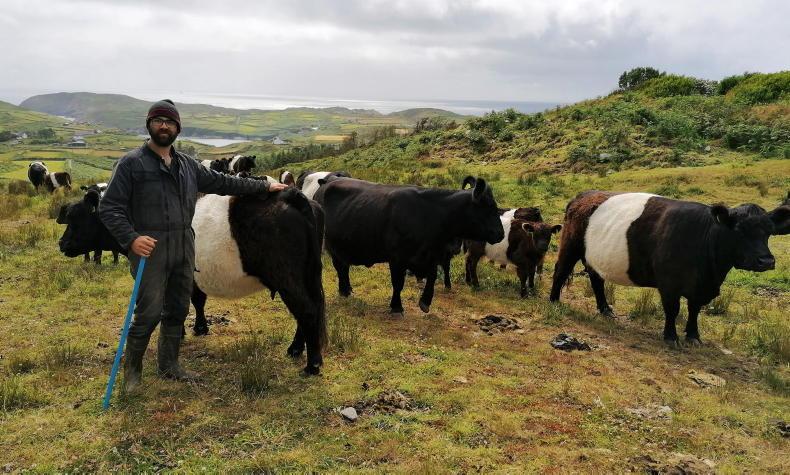
The herd are out wintered usually on some of the roughest terrain.
Mirroring mainland suckler farming, the Voarino farm is fragmented. In three divisons around the island, it’s mainly rough grazing, but as Brennus explains, this suits the Belted Galloway herd he has since developed.
“As I’m pretty new to farming, I wanted something that was easy to manage. So in 2017, after doing some research, I thought Belted Galloways would suit. They are a milky enough breed, have no horns, are easy to calve and they’re out-wintered, so I thought they would suit here.”
The first port of call was to John McHugh in Roscommon, the breed PRO in Ireland, where the Voarinos purchased a bull and unrelated cow from him and sourced another cow in the area too. Returning home with their starter herd, they headed to Scotland for their next purchases.
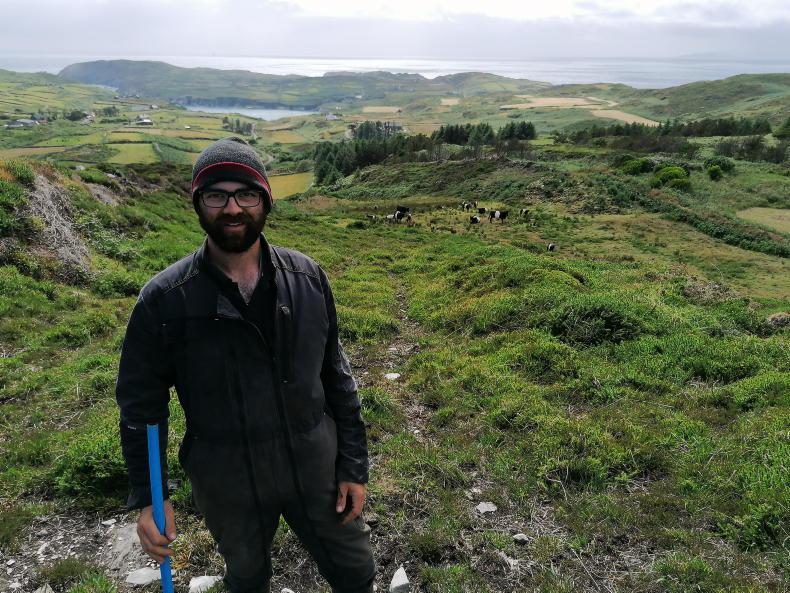
Much of Brennus Voarino's farm consists of rough grazing, which suits his herd of Belted Galloway cows.
“We ended up importing six heifers from two farms there. There’s around 35 animals in total, including 14 cows. Calving usually takes place from early March. If I calve too early, I have no grass as it gets burnt off by salt blown in from winter storms.
“When we had four cows, it felt like we couldn’t get more and now we’re at 14. We could go a little bit more, as the lands are reseeded.
“I only keep heifers if I think they are good enough and every year I keep four bullocks which are fattened and finished under 30 months. So there’s about eight bullocks between the one and two year olds and I keep them on one of the out farms.”
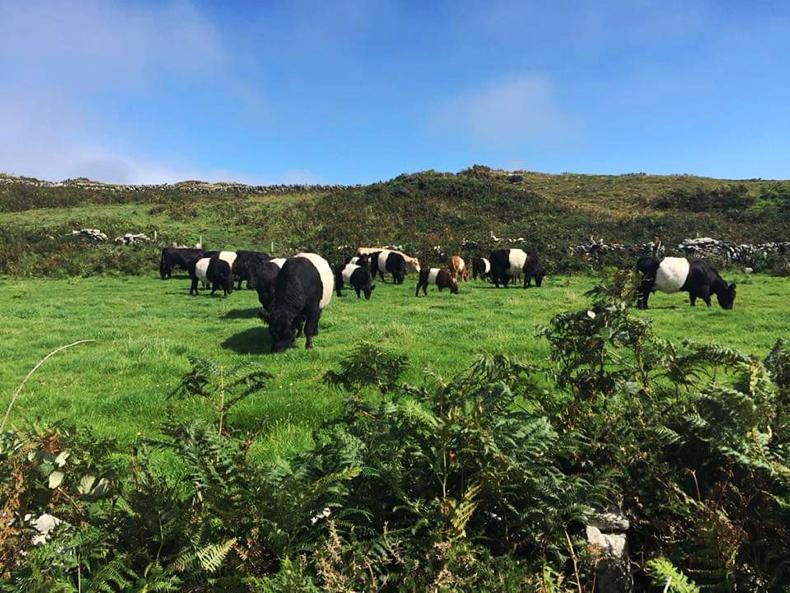
Brennus runs a herd of Belted Galloway cows on his farm in Cape Clear island off the coast of Cork.
The beef from these animals is sold to local customers, including the Michelin star restaurant Customs House in Baltimore.
Brennus has also sold some bulls to dairy farmers on the mainland and sells lambs locally from his flock of 20 Lleyn ewes, which run on the roughest portion of the farm.
To add to the livestock, his fiancée Samantha is a beekeeper with 14 bee hives and the honey is harvested from July on.
Reseeding takes place in spring on fields where cattle have been out wintered.
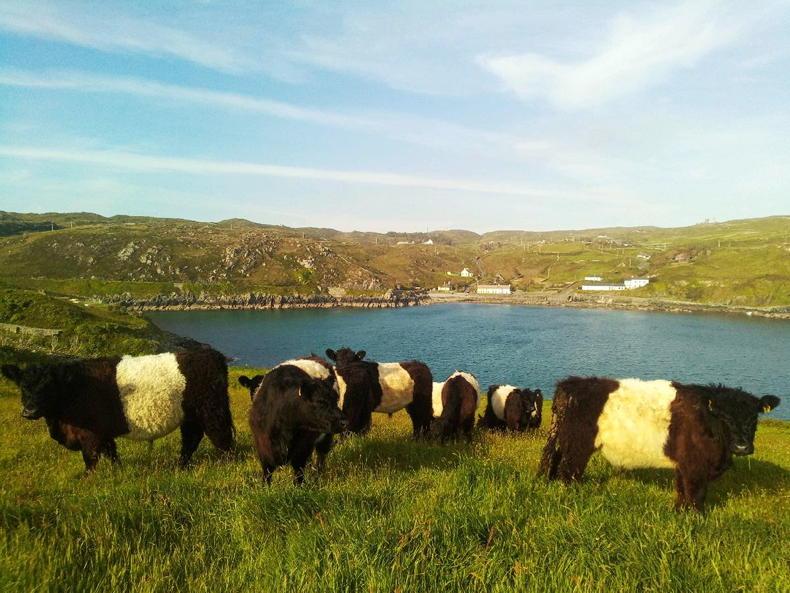
The bullocks graze a part of the farm overlooking one of the harbours on Cape Clear island.
“That’s our ploughing I suppose and it has worked well so far. I’m not certified organic, but I don’t use sprays or fertiliser I just use lime on the land and it’s made a big difference.”
In 2019, the farm was transferred to Brennus and he commenced the distance learning course with Teagasc. That was a good experience and went better than expected, resulting in Brennus becoming a finalist in the Teagasc Student of the Year awards this year.
“It was a total surprise. I was used to college experience but I found the practical stuff was very good. To be in a shed with other farmers of my age and be shown how to do things, it was very beneficial. The staff in the college were very helpful for me. If there was rough weather and I had to leave early to make the ferry, they let me off.”
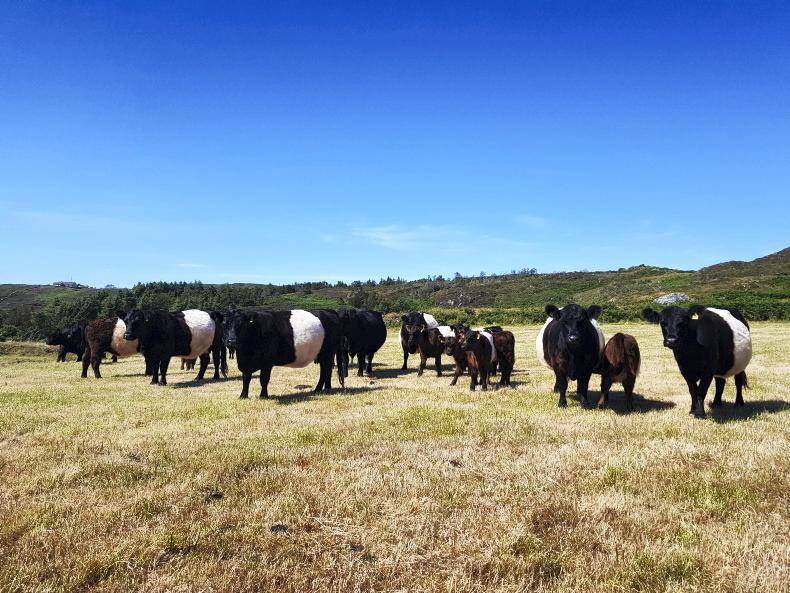
The herd cleaning up a silage paddock.
Not all the course content was relevant to Brennus though.
“It was designed for the bigger mainland farms. We have to do things slightly different on the island. We don’t have sheds or slurry and there’s no AI. We get worse weather too. Nothing grows here until end of April, so trying to get animals grazing in February didn’t apply. Every farm is different, it’s just we’re very different.”
While elements of island farming are different to mainland farmers, there are some similarities, chiefly the age profile.
“I’m the youngest farmer on the island. Sometimes that’s a bit scary. Most farmers here are 50 and over. I’m not sure what the future is, as there seems to be few interested in taking over farms. I wouldn’t want to be on my own.”
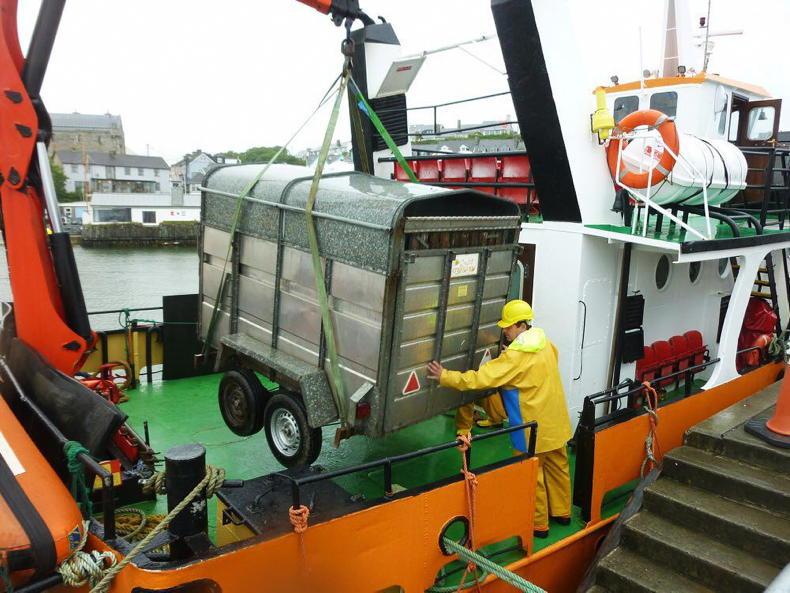
Cattle going to and from Cape Clear Island must do so inside a trailer which is loaded onto the ferry.
Farming on an island has its challenges. There’s no freshwater river on Cape. All water is supplied from a series of wells and pumped into large tanks which serve the island. These are located on a hill on the Voarino’s farm.
Everything comes in and out on a boat and everything takes longer, as Brennus explains: “Like the mart, you have to book ahead for the boat and they can only take two trailers on the boat with six animals between them. It’s first come first serve and if it’s full you just have to wait until next week.
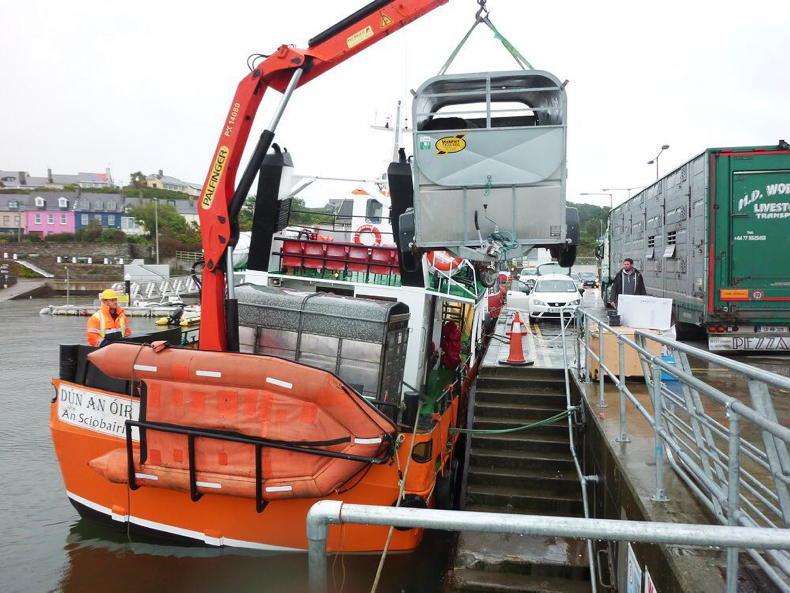
The Belted Galloways being transported from Scotland to the Voarino's farm on Cape Clear island. The journey took 30 hours to complete.
“If the weather is very good, we’re able to book the barge and that can take more, but it’s not always possible to book that. We’ve to do a bit of everything. I’m a fisherman as well. No one lives off farming alone on the island.
“Once a week, I go hauling pots for lobsters and crab with the O’Driscolls. It’s the last fishing boat on Cape. Island farming has its challenges, but there’s a good spirit.”
New entrant is a term that has firmly placed itself in the Irish farming vocabulary over the last decade. Usually referring to those who have converted their farms into dairy operations, the term also applies to Brennus Voarino. Except he’s a different type of new entrant – he’s new to farming. Originally from near Nice in the south of France, his family moved to Cape Clear Island off the west Cork coast in 2008.
“My parents always wanted to move to Ireland, so they bought a 110ac farm here 14 years ago. When we started, much of the land was over grown and after I finished my geology degree in May 2014, we applied for a herd number and bought four cows, two Angus, an Aubrac and a Hereford. I took a year out and spent the time fencing the farm. After that, I did a masters and worked away for a while, but I didn’t like the office work and wanted to go farming.”

The herd are out wintered usually on some of the roughest terrain.
Mirroring mainland suckler farming, the Voarino farm is fragmented. In three divisons around the island, it’s mainly rough grazing, but as Brennus explains, this suits the Belted Galloway herd he has since developed.
“As I’m pretty new to farming, I wanted something that was easy to manage. So in 2017, after doing some research, I thought Belted Galloways would suit. They are a milky enough breed, have no horns, are easy to calve and they’re out-wintered, so I thought they would suit here.”
The first port of call was to John McHugh in Roscommon, the breed PRO in Ireland, where the Voarinos purchased a bull and unrelated cow from him and sourced another cow in the area too. Returning home with their starter herd, they headed to Scotland for their next purchases.

Much of Brennus Voarino's farm consists of rough grazing, which suits his herd of Belted Galloway cows.
“We ended up importing six heifers from two farms there. There’s around 35 animals in total, including 14 cows. Calving usually takes place from early March. If I calve too early, I have no grass as it gets burnt off by salt blown in from winter storms.
“When we had four cows, it felt like we couldn’t get more and now we’re at 14. We could go a little bit more, as the lands are reseeded.
“I only keep heifers if I think they are good enough and every year I keep four bullocks which are fattened and finished under 30 months. So there’s about eight bullocks between the one and two year olds and I keep them on one of the out farms.”

Brennus runs a herd of Belted Galloway cows on his farm in Cape Clear island off the coast of Cork.
The beef from these animals is sold to local customers, including the Michelin star restaurant Customs House in Baltimore.
Brennus has also sold some bulls to dairy farmers on the mainland and sells lambs locally from his flock of 20 Lleyn ewes, which run on the roughest portion of the farm.
To add to the livestock, his fiancée Samantha is a beekeeper with 14 bee hives and the honey is harvested from July on.
Reseeding takes place in spring on fields where cattle have been out wintered.

The bullocks graze a part of the farm overlooking one of the harbours on Cape Clear island.
“That’s our ploughing I suppose and it has worked well so far. I’m not certified organic, but I don’t use sprays or fertiliser I just use lime on the land and it’s made a big difference.”
In 2019, the farm was transferred to Brennus and he commenced the distance learning course with Teagasc. That was a good experience and went better than expected, resulting in Brennus becoming a finalist in the Teagasc Student of the Year awards this year.
“It was a total surprise. I was used to college experience but I found the practical stuff was very good. To be in a shed with other farmers of my age and be shown how to do things, it was very beneficial. The staff in the college were very helpful for me. If there was rough weather and I had to leave early to make the ferry, they let me off.”

The herd cleaning up a silage paddock.
Not all the course content was relevant to Brennus though.
“It was designed for the bigger mainland farms. We have to do things slightly different on the island. We don’t have sheds or slurry and there’s no AI. We get worse weather too. Nothing grows here until end of April, so trying to get animals grazing in February didn’t apply. Every farm is different, it’s just we’re very different.”
While elements of island farming are different to mainland farmers, there are some similarities, chiefly the age profile.
“I’m the youngest farmer on the island. Sometimes that’s a bit scary. Most farmers here are 50 and over. I’m not sure what the future is, as there seems to be few interested in taking over farms. I wouldn’t want to be on my own.”

Cattle going to and from Cape Clear Island must do so inside a trailer which is loaded onto the ferry.
Farming on an island has its challenges. There’s no freshwater river on Cape. All water is supplied from a series of wells and pumped into large tanks which serve the island. These are located on a hill on the Voarino’s farm.
Everything comes in and out on a boat and everything takes longer, as Brennus explains: “Like the mart, you have to book ahead for the boat and they can only take two trailers on the boat with six animals between them. It’s first come first serve and if it’s full you just have to wait until next week.

The Belted Galloways being transported from Scotland to the Voarino's farm on Cape Clear island. The journey took 30 hours to complete.
“If the weather is very good, we’re able to book the barge and that can take more, but it’s not always possible to book that. We’ve to do a bit of everything. I’m a fisherman as well. No one lives off farming alone on the island.
“Once a week, I go hauling pots for lobsters and crab with the O’Driscolls. It’s the last fishing boat on Cape. Island farming has its challenges, but there’s a good spirit.”












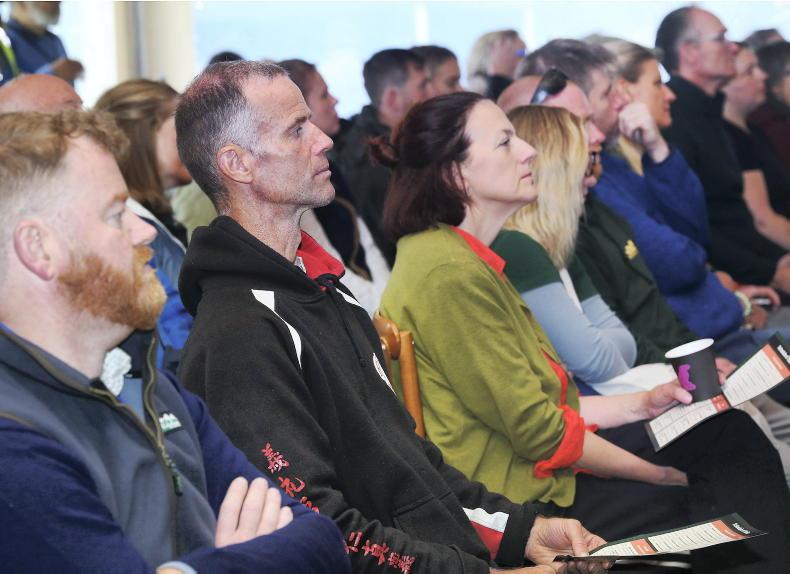
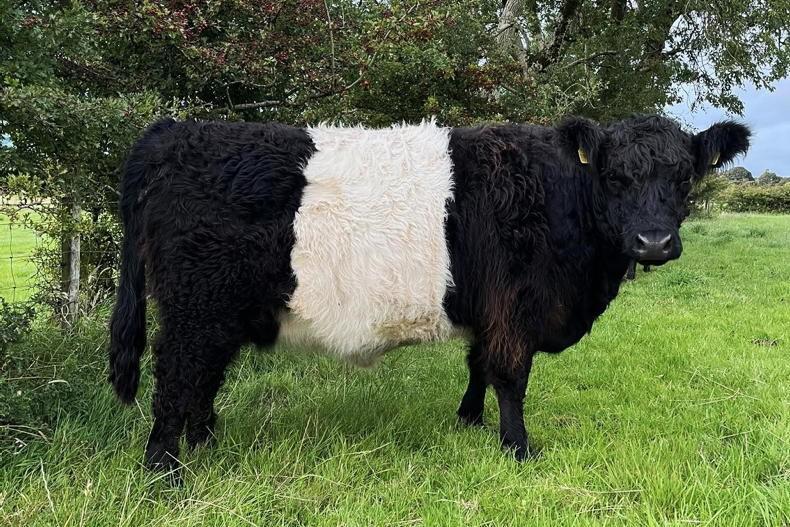


SHARING OPTIONS